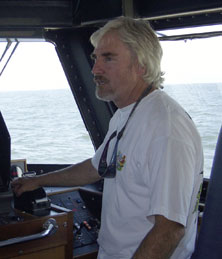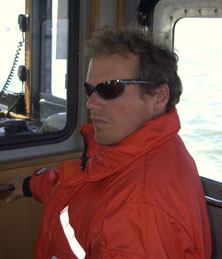Lewis & Clark Trails
Air Date: Week of June 13, 2003
As part of our ongoing series about the people who live and work today along the route of Lewis and Clark, producer Barrett Golding sends us an audio postcard about the Columbia River, and the bar pilots who help guide ships through the waterway.
Transcript
CURWOOD: This year marks the 200th anniversary of the Lewis and Clark expeditions.
RIVER BOAT CREW: Paddle, come on, harder!
[NATIVE AMERICAN SINGING]
CURWOOD: We wondered who lives and works along the trail now, from the Northwest Coast to the mouth of the Missouri.
WOMAN [COUNTING TO DRUM BEATS]: One, two, three.
[MUSKET SHOT, FROGS/CRICKETS]
CURWOOD: Producer Barrett Golding bicycled the entire Lewis and Clark Trail and sent us a series of audio postcards.
[MAN’S VOICE ON TWO-WAY RADIO]
CURWOOD: Like this one from Astoria, Oregon, where members of the Columbia River Bar Pilots Association board ships from foreign nations and help shepherd them up the river. Phil O’Shaughnessy and first mate John Leither told Golding that each bend in the river brings different environmental issues that are often the subject of fierce local debate.
 Phil O’Shaughnessy Phil O’Shaughnessy |
 First mate John Leither First mate John Leither
O’SHAUGHNESSY: Yeah, in fact, one of the controversies right now in this whole area is dredging this river. Because ships get bigger every year. And what keeps a ship from really being out of control as far as size is the average depth of harbors that it has to go into. Here, what they call the controlling depth is 40 feet. So that means the ship can load right down to 40 feet and not an inch more. Obviously, if they could carry a few more inches, that would be more profit. And right now, the big controversy is to dredge the river down to, I think it is 43 feet, just to give it another three feet. And that would make the shippers happy. And then, in competition to deeper ports like Seattle, it would also keep us more viable for competition. LEITHER: I heard an interesting thing from one of the bar pilots, that those few feet aren’t really going to make any difference in the shipping that comes here. The only difference is going to be, these guys are going to be able to load heavier which actually… It doesn’t make any more jobs. Actually, if anything, it cuts down on jobs because they are going to be moving less ships. If, say, they have a load that takes five ships that are loaded at 40 feet, but if they can load up a little heavier, they can cut it down to four ships? There goes a lot of revenue, right there, for a lot of people: river pilots, the longshoremen, and it goes right down the line. [MAN’S VOICE ON TWO-WAY RADIO] O’SHAUGHNESSY: Well, there is a lot of… when is it going to be deep enough? Because as long as you can dig a hole deep enough to put the ship in, they will build a ship big enough to fill it. So at some point, you have got to say, “Hey, wait, enough is enough.” Because you don’t know what you are doing to the environment when you are artificially deepening the channel. Since there was already a lot of pollutants in the river, they say that it’s impacted in the mud. And when you start dredging, you are going to start to dredge all that up. You are going to put it in solution again, which would affect the fishing, and then the marine life. LEITHER: And, again, one thing we should straight before-- both of us are actually in favor of dredging the channel to be safe for the traffic to go through. But it’s this extra depth that we are talking about it dredging. But dredging itself pretty much always has to happen because sand and silt and whatnot, this river is always moving, and the sand moves. And so that’s a constant thing. [MAN’S VOICE ON TWO-WAY RADIO] CURWOOD: Phil O’Shaughnessy and John Leither are members of the Columbia River Bar Pilots Association. Barrett Golding’s portraits of the Lewis and Clark Trail: 200 years later are part of Hearing Voices, funded by the Corporation for Public Broadcasting. For more audio, photos and interviews from the trail, please visit our website, livingonearth.org. Also coming up on our website: the view from Three Gorges. Earlier this month, China started pouring water into the reservoir behind the giant Three Gorges Dam, the world’s biggest hydroelectric project and one of the most controversial. By the time it is completed in 2009, the dam will produce more than 80 billion kilowatts of energy. But it will have also displaced more than a million residents of Central China. Its impact on the region’s environment is yet to be totaled. Photographer Ed Burtynsky has captured the intensity of one of the world’s largest engineering projects, and starting next week, his images of the Three Gorges Dam will be available on our website, livingonearth.org. That’s livingonearth.org for a close up look at the Three Gorges Dam. ANNOUNCER: Funding for Living on Earth comes from The World Media Foundation. Major contributors include the William and Flora Hewlett Foundation for coverage of Western issues, and the Richard and Rhoda Goldman Fund. Support also comes from NPR member stations and Bob Williams and Meg Caldwell, honoring NPR’s coverage of environmental and natural resource issues, and in support of the NPR President’s Council, and Paul and Marcia Ginsberg in support of excellence in public radio. Living on Earth wants to hear from you!Living on Earth Newsletter [Click here]
Donate to Living on Earth! NewsletterLiving on Earth offers a weekly delivery of the show's rundown to your mailbox. Sign up for our newsletter today!
|





